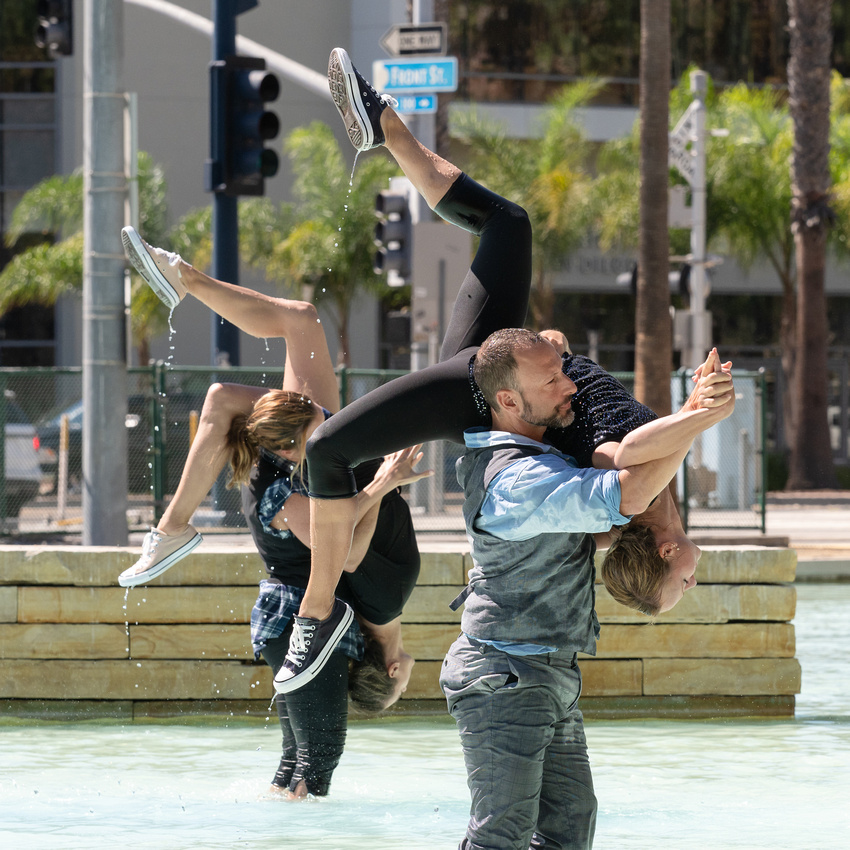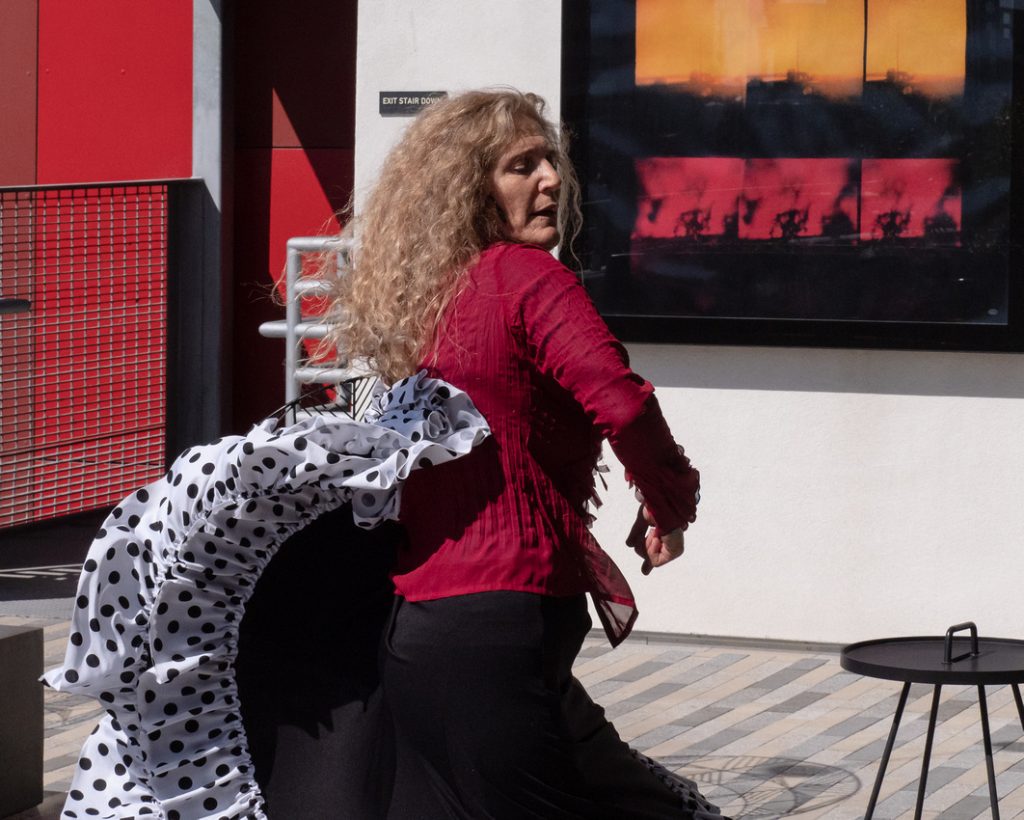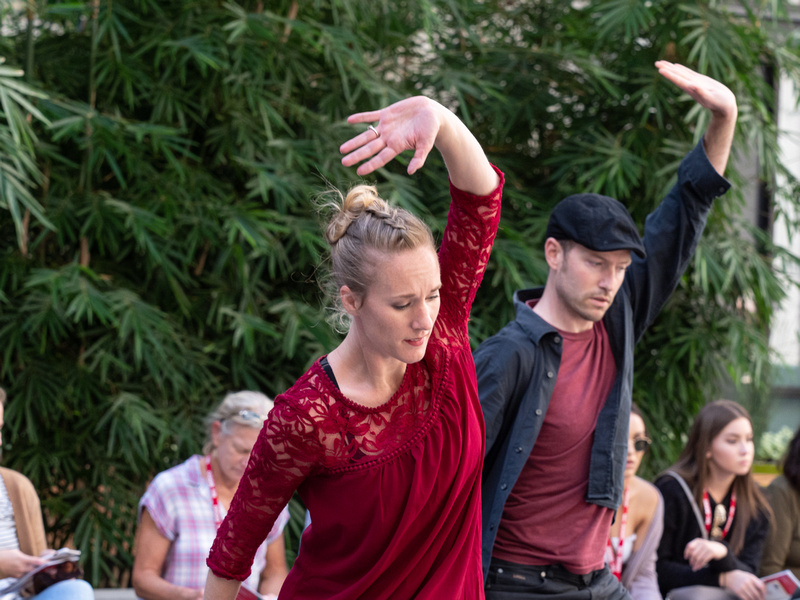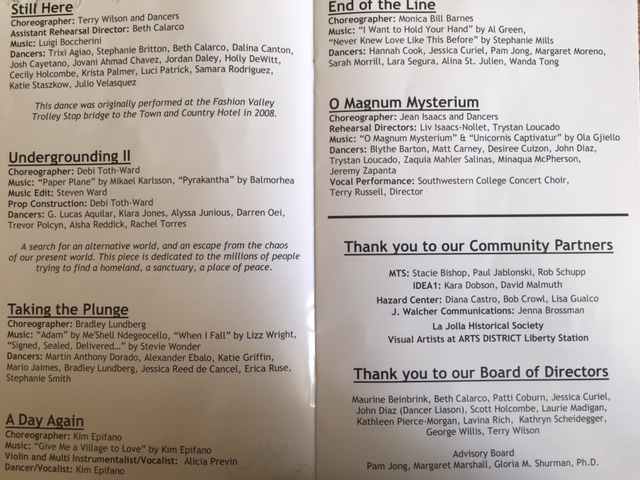‘Best of Trolley Dances’ Soars with Voices and Water, Concern for Homeless
There are more than 50 trolley stations in the San Diego Trolley system, yet many residents and visitors never zoom on the red trains through downtown and surrounding neighborhoods.
That began to change in 1999 when the cultural adventure Trolley Dances began.
Artistic Director Jean Isaacs couldn’t afford a theater for her company San Diego Dance Theater; she had to improvise. She partnered with the San Diego Metropolitan Transit System and dancers performed site-specific work in unexpected places.
Dances are specifically crafted to respond to the physical environment, such as architecture, history, nature, even water. Over the years, thousands have made Trolley a tradition, and it’s become a rite of passage for hundreds of dancers.
To celebrate its 20th Anniversary Best of Trolley Dances, San Diego Dance Theater brings back six favorite dances voted by Trolley fans. In past years, the urban discovery ran over two weekends. This year, guided tours begin at Hazard Center of Friars Road in Mission Valley, and there’s only one 3-day run, Oct. 5, 6, and 7. No surprise, tour groups are extra-large, and for performers and viewers, it’s an exciting reunion of friends and memories.
The experience begins when 14 men and women dressed in ragged clothing appear on a patio near the trolley tracks. Still Here, choreographed by Terry Wilson and dancers, captures the fear and isolation of people who are homeless. Two men fight over a shopping cart. When the men and women dance in unison their teary eyes meet ours. They struggle to reach upward and without warning disappear into the shopping structure.

“Still Here,” choreographed by Terry Wilson and Dancers, opens “Trolley Dances 2018” Image: Jim Carmody
It would be much easier to perform six dances in a theater, but site-specific work is powerful.
Isaacs, SDDT, and dozens of volunteers work with the MTS for months to plan a route and obtain permission. Together they slog through a logistical swamp of permits, insurance, and red tape, and finally select unique areas to discover and set dances, such as empty lots along the trolley tracks, fountains, stores, apartments, and stairways.
We walk by apartments and a few people crouched near a chain-link fence to find the second dance. The winding sidewalk narrows with the San Diego River on our left, and trolley tracks on our right.

Dancers emerge from a camouflage blanket of twine in “UndergroundingII” by Debi Toth-Ward.
We stop under a concrete overpass to view Undergrounding II, choreographed by Debi Toth-Ward. A blanket of string and twine wiggles on the dusty riverbank and seven dancers emerge. We are trespassing on their territory. They kick up dust when they run and leap into the arms of another. When they climb onto each other, they build a human fortress. Men and women portray warriors and their beautiful skin is shiny. Music rumbles and traffic roars, and we are enthralled by this tribe and their search for sanctuary. If we pass this place again, we’ll expect to see them.
About 45 minutes into the tour, we climb onto the Green Line trolley. We ride over the river and through the Fashion Valley mall and golf course. We pass the sites of previous Trolley Dances–a nature path and apartment complex swimming pool.
As we ride, couples and groups of women plan for lunch and shopping. Others ride solo and enjoy the view that can only be seen from the trolley. Commuters climb on at Old Town and don’t seem to notice the animated crowd wearing red lanyards. Instead, they sleep or play with their phones.

Dancer/Choreographer Bradley Lundberg partners with Jessica Reed de Cancel in “Taking the Plunge.” Dancers Katie Griffin and Erica Ruse can be seen behind them. Image: Jim Carmody
We pass a beautiful pool and water spraying, and get to see it up close after a short walk. Taking the Plunge, choreographed by Bradley Lundberg, is one of the most attractive and joyful dances ever presented. Dancers fully clothed wade through the shallow Children’s Park Fountain and slowly weave through poles that spray water on their heads. We feel the attraction and apphrension.
Men and women pair up and caress each other as we hear the lyrics “Oh, if I look down now, tell me will I fall…” For about 10 minutes, we forget that we are in a park across from the Convention Center. We try to imagine ourselves balancing in handstands on the edge and lifting a partner, and the absolute joy of splashing in water five times a day over three days. It is also a treat to watch Lundberg partner with Jessica Reed de Cancel, as he did when he first presented the work.
Now fully energized, we return to the trolley, switch to the Blue Line and we walk some more. We pass the impressive library and luxury apartments, the New School of Architecture and dozens of Bird scooters. Once at IDEA1 in East Village, some ride the elevator and others climb stairs to the top floor, and it is worth the effort.

Kim Epifano sings and dances, plays accordion and tells stories in “A Day Again.” Image: Jim Carmody
Whirling her golden hair and skirt, Kim Epifano, from San Francisco, invites us into the airy clubhouse as if she knows everyone personally. She rests on a yellow sofa but is revived by the sound of violinist Alicia Previn (who is Andre Previn’s daughter). The two spin a tale of a gypsy woman and Epifano sings, plays accordion, and dances her life story of family and world travels, all of it true.
Humorous and unpredictable, A Day Again reminds us that life is good and we’re never too old. Epifano is a master at storytelling and imagery. When she grabs a fluffy foot stool, it becomes a Russian hat. She insists that we are all talented and could perform in her clubhouse. Her final bit of advice is to be nice.
Epifano has been a contributor to Trolley Dances since its inception. She’s jumped on beds in hotels and ridden a bicycle in Chicano Park. She also created a San Francisco version that celebrates its 15th Anniversary on Oct. 20 and 21. Jean Isaacs will also present work.
The final two dances this year are on the ground floor of IDEA1. Set to a medley of bouncy tunes, women in red party dresses strut and boogie in End of the Line. Created by Monica Bill Barnes, the work incorporates shimmies and shoulder shrugs we might try when nobody is watching. The women steal a dance with members of the audience and finally retreat up a stairway. 
All senses are in overdrive during Isaacs’ masterful O Magnum Mysterium, accompanied by the Southwestern College Concert Choir.
When it was performed in 2013, Sacra Profana Vocal Ensemble was hidden in the rafters of the Monarch School lobby. On the ground floor of IDEA1, the choir assembles near the dancers. The result remains a sonic injection of joy with harmonics that make your skin tingle.
Eight dancers burst and scatter with the precision of rotating planets in an orbit. Arms roll up and down so fast they blur. The group charges forward, but recoils as if hitting an invisible wall. They keep a relentless pace. In spite of rough flooring, they stay in unison, and carry each other, pausing only to glance upward toward a modern structure that opens to a clubhouse and sky. Many of the dancers have worked with Isaacs for a decade or more. They move with a sense of urgency and emotion that comes from trust and love for the art form and its creator.

Blythe Barton and Matt Carney partner in “O Magnum Mysterium” by Jean Isaacs. Image: Jim Carmody
Trolley Dances is an adventure and demands walking and trolley riding. Before hopping aboard, be sure to wear sturdy shoes and relax. Most tours take about three hours. Expect to see glorious dance in unexpected places and people living outdoors. In many ways Trolley Dances is a workshop for seeing a community with new eyes.

For more images from this production visit: https://jimcarmody.zenfolio.com/trolleydances2018/hb90ec7a2#hb91bf44d
San Diego Dance Theater www.sandiegodancetheater.org
San Francisco Trolley Dances Oct. 20, 21.

Kris Eitland covers dance and theater for Sandiegostory.com and freelances for other publications, including the Union Tribune and Dance Teacher Magazine. She grew up performing many dance styles and continued intensive modern dance and choreography at the Univ. of Minnesota, Duluth, and San Diego State Univ. She also holds a journalism degree from SDSU. Her career includes stints in commercial and public radio news production.
Eitland has won numerous Excellence in Journalism awards for criticism and reporting from the San Diego Press Club. She has served on the Press Club board since 2011 and is a past president. She is a co-founder of Sandiegostory.com. She has a passion for the arts, throwing parties with dancing and singing, and cruising the Pacific in her family’s vintage trawler. She trains dogs, skis, and loves seasonal trips to her home state of Minnesota.
